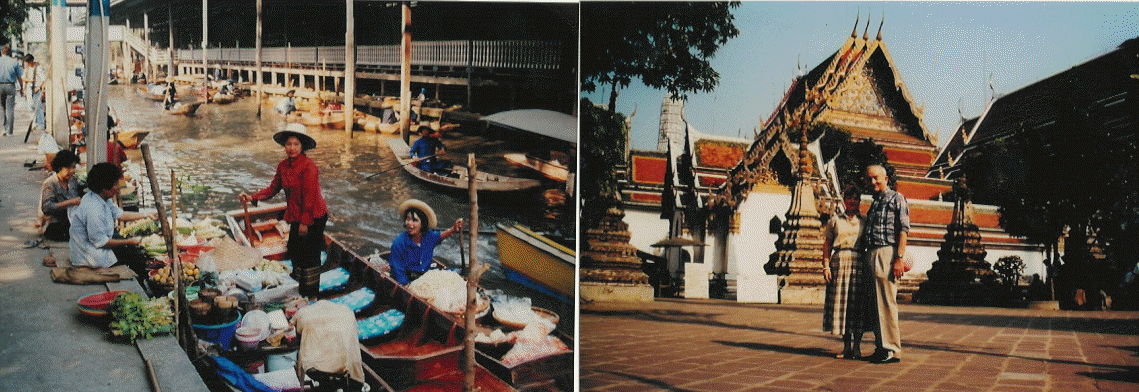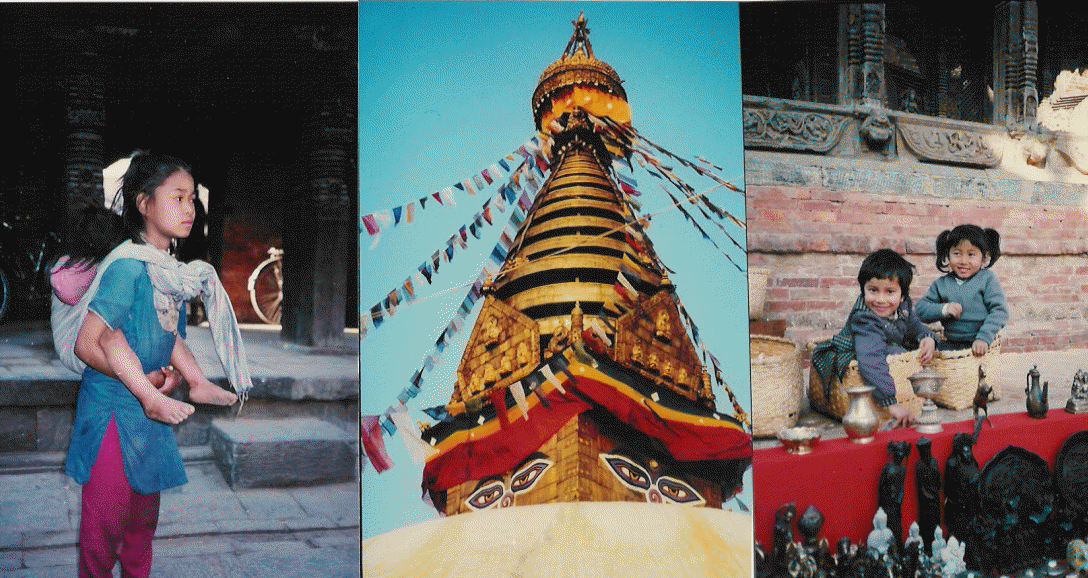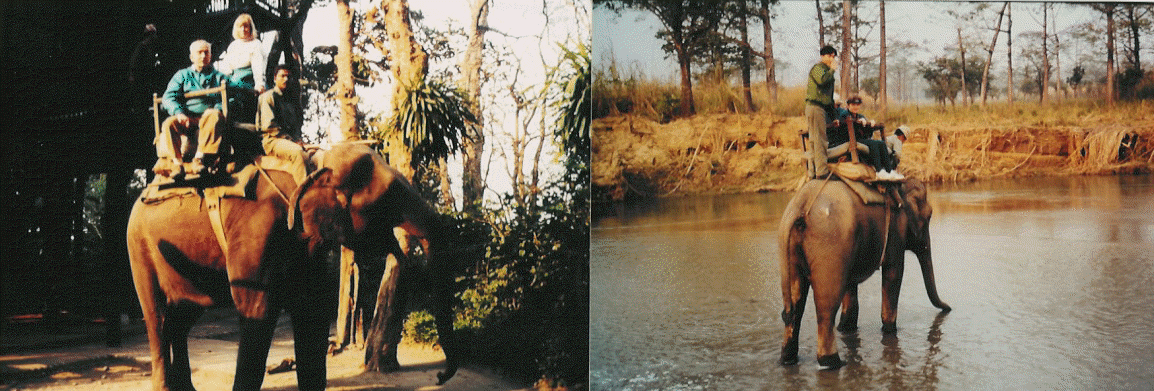
Nepal, Thailand (1993)
Rendezvous in Katmandu
We both left White Bear Lake before the weekend. Our destination was India. The Baukols flew east to London. We flew west to Bangkok. The reasons we traveled in opposite directions were basically scientific ones. We wanted to study the differences between eastbound versus westbound jet lag . . . and we wanted to confirm that the world is round once and for all. Our goal was to meet in Bombay. It was not to be.
Bangkok. At 4 am Monday morning, the phone rang in our Bangkok hotel room. It was Ron calling from the London airport (9 pm, Sunday evening) to say that he'd received an urgent message from 3M headquarters in Bombay saying that the road from the airport to the city was closed due to rioting between the Hindus and Moslems (prompted by the destruction of the mosque in Ayodhya in December) and that we should cancel our plans to come to India. Unable to telephone our travel agent in Delhi ( 2 am, Monday morning ), we called Jill in San Francisco (5 pm, Sunday afternoon) and got their Delhi representative's facsimile number. A hundred dollars worth of fax exchanges and phone calls later and with everlasting gratitude to global communication satellites, we had switched to Plan B . . . a rendezvous in Katmandu on Wednesday.
Profiting from this extended layover in Bangkok, we contacted Brian Dalton, who is located in Bangkok with the foreign service and he very generously spent the day on Sunday showing us the sights of Bangkok . . starting with a boat ride along the canals to a local market, to several of the magnificent Buddhist temples (where Brian and I got a Thai massage in a massage parlor next to one of the temples) and finally back to his apartment near the U.S. embassy. Brian is assigned to the Vietnam desk at the embassy and spends two weeks a month in Hanoi processing special visa applications for Amer-Asians and former political prisoners, who enjoy special visa status if they can prove their stories to Brian . . a fascinating and challenging responsibility. He expects to relocate to Vietnam in the near future once the U.S. establishes a diplomatic relationship with the government there.
 |
Floating Markets Bangkok Temple
The next day we took an all day bus tour upland near the Burmese border to visit a floating market and the site of Bridge Over the River Kwai, made famous by a movie in the late 50's of the same name. The wooden bridge has long since been destroyed but the iron bridge still stands as an impressive monument to the 6,000 allied prisoners of war who died there constructing the bridge as a part of the infamous Death Railway which connected Thailand to Burma and India.
Katmandu. Katmandu has always seemed to me more like a fictional place rather than a real city but in we flew past the Himalaya mountains and the great Sagarmatha (Mt. Everest) and down into the Katmandu valley, drove to the Shankar Hotel (a 19th century former palace and birthplace of the present queen) and there were Ron and Gay sitting on the expansive front lawn waiting to greet us . . . half a world away from White Bear Lake. After checking in, we went downtime to Durbar Square, the temple filled, city center and out to the famed Swayambhunath Buddhist temple in the hills overlooking the valley for a quick orientation then back to the hotel for a dinner together by candlelight . . . . prompted not so much by a desire for ambiance but because the city observes a power outage every morning and evening from six to eight to conserve fuel. So you go to bed or wake up to candlelight throughout the city on alternate days.
 |
Young babysitter Swayambhunath Temple Young street sellers
The next morning we flew out of the valley and over the mountains to the Royal Chitwan National Park on a Royal Nepal Airlines . . a ten seat (including the pilot) prop plane . . for a great flying experience. Since there were only four of us going to Chitwan, the pilot opted to fly instead to a more distant "airport" (actually a grass field) and we were treated to a two hour bus ride through the Terai countryside at no extra cost to our lodge at Tiger Tops.
Tiger Tops.Tiger Tops is a jungle lodge built on poles. Unlike the more famous Tree Tops in Kenya, where the animals come at night to the waterhole, at Tiger Tops you go to the animals . . on elephant back . . and the elevated lodge allows you simply to step off the ten foot high porch and on to the back of your elephant.

|
So early the next morning with the mist still hanging heavily in the air, we set off on our first elephant back safari taking four elephants each with two riders, a driver (mahout) sitting on the elephant's head and a spotter/naturalist standing on the back. The safari took us through thick stands of 25 foot high elephant grass, over rivers and through the jungles. The object of the safari was to spot one of the 25-30 Royal Bengal tigers which roam through the park. In three separate safaris, we failed to spot a tiger but we did see a number of one-horned, Asian rhinos, hog and spotted deer, lemur and rhesus monkeys, mongoose . . . and enough tiger tracks and claw marks on trees to know that the tigers were nearby. In fact, on our final ride we found parts of a one month old rhino which we had spotted just the day before with its mother. From the nervous growling and trumpeting of the elephants at the kill site, I suspect that the tiger wasn't too far away.
Elephants are amazingly intelligent and respond to from twenty to thirty commands . . with only a single spoken word required to get them to kneel, pick up a log or pull up a small tree. The camp has seventeen elephants in their herd . . most bought in India for about 10-15,000 dollars per animal. We were learned a lot from the naturalists there about elephants and we're prepared to explain the differences between an African elephant and an Asian elephant or just about anything else you might care to know about elephants.
On most rides, it was just Ron, Gay, Val and me with Nepalese staff coming along on the other two elephants . . so it was the thrill of a lifetime with some unforgettable sights that you can only partially capture on film. After three days, we parted company with Ron and Gay. They flew back to Katmandu while we drove to Pokhara, the starting point for our trek. It was great being on safari with the Baukols again and brought back a lot of memories of our trip to Africa with them four years ago.
Himalayan Trek. Pokhara is two hundred kilometers west of Katmandu and has only been accessible by road for the last twenty years. It was there that we had our first view of Fish Tail (Machhapuchhare) mountain and the Annapurna range. It is a town of dirt roads and few amenities but our hotel was a nice surprise located across a lake (Phewa Tal) and is reached only by a raft which a boatman pulls back and forth across the lake by a rope.
We met out Sherpa guide, kitchen boy and two porters early the next morning at the edge of town where they were already packed up and ready to climb. They pointed to the top of the nearest mountain as our initial destination and we all started off at a brisk pace. Soon we were past the rice paddies and into the climb up a 3000 feet ascent . . virtually all on stone stairs built into the mountains to resist wash out from the annual monsoon rains.
I figured that all I had to do was to stay up with the two diminutive, teen aged girl porters, who each carried fifty pound loads on their backs in wicker baskets. Well, like the Eveready Bunny, they just kept on climbing and climbing and climbing . . while we kept on panting and gasping and resting. It was tougher than we expected . . but we eventually made it to Sarangkot after three hours of hard climbing . . and a lot of rest stops. It was the rough equivalent to climbing to the top of the Empire State Building . . five times !! . or three hours on the stair machine at the club but without oxygen. But it was worth it!
 |
On the Trail At the Top with our Sherpa Porters
At the top the porters made camp for lunch, laid out some cushions and cooked a lunch of hot tea, vegetable and rice which we ate in splendor overlooking the mountain range. The five mile afternoon trek to Naudanda was along a ridge line so a lot easier and more relaxing and gave us a chance to get a glimpse into the lives of the Nepalese country folk who live out their lives in the mountains in a tough but in many ways more peaceful and idyllic life away from the crowds, noise and pollution of the cities below. We pitched camp in an open field behind a small farmhouse near Naudanda, had another Nepalese meal cooked over an open fire and retired to our tent soon after the sun went down at eight o'clock.
The next morning our destination was Dhumpus . . down the mountain into a river valley and up the side of the next mountain. At that point, I would have almost opted for a rope bridge across the valley . . but down we all went and back up the other side arriving in Dhumpus in time for our final lunch and for an even more spectacular view of the mountains which, unfortunately, were partially hidden most of the time by clouds. Our final leg was a brisk, downhill trek to the valley and our waiting driver. They say you use more muscles walking downstairs than up . . and judging from how stiff we felt the next morning, it is certainly true.
Our final day in Nepal was spent driving back from Pokhara to Katmandu and a final visit to Durbar Square for some last minute pictures, shopping and an unexpected audience with the `living goddess' of Katmandu . . a young girl chosen from the townspeople who lives in a temple, receives supplicants and is carried around town once a year in one of their biggest religious ceremonies. She is retired when she reached puberty, goes on to lead a secular life and is replaced by another. We just happened to be in the courtyard of her residence when the shutters opened above us and a six year old girl costumed and made up like an adult looking down on us with disinterest. It was a strange moment. I guess I'd be even more impressed if I hadn't already been married to my own living goddess for the past thirty four years of my life.
So we set out to go to India but ended up in Katmandu. Although we were disappointed initially that our plans had to be changed, we certainly have no regrets about the trip which was absolutely one of our best ever. We'll just have to see the Taj Mahal another day.